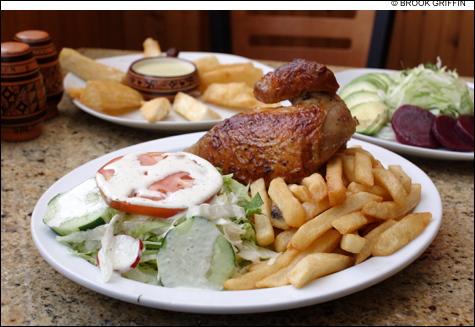
BIRDLAND: Try the rotisserie chicken at Machu Picchu. |
| Machu Picchu Charcoal Chicken & Grill | 617.623.7972 | 25 Union Square, Somerville | AE, DC, DI, MC, VI | Open Mon–Thurs, 11:30 am–10 pm; Fri and Sat, 11:30 am–11 pm; and Sun, 11 am–10 pm | Beer and wine | No valet parking | Sidewalk-level access |
Having made a success of their remarkably authentic Peruvian restaurant in Union Square, the owners of Machu Picchu moved it to a bigger space up 30 yards across the street. Then they cleaned out that original room, installed a rotisserie, modernized the décor, and opened up a new restaurant in the old space — confusingly, also called Machu Picchu — with an even-less-expensive menu of Peruvian treats (and some holdovers). Want a $9 chicken dinner or a $14 steak? You could put up with a little pan-flute music for that, right?Curiously, the yucca fries ($6.95), native to Peru and served with most entrées, are only middling, not really crisp, while the plantains — from Africa — are wonderfully sweet, and the yuquitas ($6.95) — native to Brazil — are glorious. This may be due to the fact that yucca is closer to pure starch than is a potato, so the symphony of starch, grease, and salt is uninhibited by too many vitamins or minerals. It also may have to do with correct frying temperatures, which are different for yucca and potatoes. Certainly the huancaina sauce, borrowed from an Andean potato dish, is a major factor in the success of Machu Picchu’s yucca fries. It’s creamy with rich flavor and real bite courtesy of the Peruvian yellow chili called aji amarillo. Another creamy sauce is available, this one green and a little less incendiary. Both make wonderful fried-yucca dips.
Choclo Peruano ($6.99), a seasonal peasant meal of corn on the cob with only eight rows of giant white kernels, is a fine traditional appetizer. It comes frozen from Peru and is served with rubbery white cheese. You could also move into the key of meat with combination street-snack platters. The “Picante” ($12.99) features grilled tripe, chicken gizzards, and pieces of beef-heart meat, all pre-treated with cumin and pepper. The beef heart, the classic “anticucho” ($7.99 à la carte), is the best, though the gizzards are too chewy and need more taste of the fire. The tripe are the easiest to eat, but don’t absorb flavor so well.

Machu Picchu has some fun salads, such as quinoa ($6.95), which is a novel use of the unusual grain. I’ve never had it as a cold molded salad, but it works better than pasta salad, garnished with avocado and few of the giant corn kernels. The Machu Picchu salad ($6.99) is similar to a garden salad, with kernels and cheese cubes. The Misti salad, served with many of the entrées, is named for a looming volcano near the mile-high colonial city Arequipa. Unfortunately, this is a modest heap of lettuce and tomato.
Familiar appetizers and small plates are less interesting. The empanada ($3.50) is a fine pastry turnover with a chopped meat and vegetable filling that isn’t at the level of the Argentine version, or even a decent Cornish pasty. But the tamale ($6.99) is enormous and certainly fills you up, as it’s mostly tamale and not much pork. I didn’t see any hot sauce bottles, so I borrowed some of the huancaina sauce.
On to the chicken. The rotisserie pollo a la brasa ($15.99/whole chicken; $8.99/half; $5.99/quarter) comes with fries and a Misti salad. The secret 24-hour marinade must feature salt or soy sauce, since the chicken — even the breast meat — is as juicy as brined Brazilian barbecue. The rotisserie gives it a nice crust. El parihuelo ($12.99), grilled half chicken, has the salt on the outside, and with it you get better side dishes, such as the plantains. Pollo al estilo ($9.99) has some tomatoes and onions, so you end up with something similar to a sauce. On the whole, stick with the pollo a la brasa.
I promised you a cheap steak, so have the churrasco ($13.99). It’s a thin, pounded chuck steak, not especially tender, but it has lots of flavor. I sort of preferred the pork-chops version ($12.99).
To drink there are two Peruvian beers. Cristal ($4) is a light, apple-y lager best enjoyed quite cold. Cusqueña — which I did not sample when I visited Cuzco, where it’s made, due to intense altitude sickness — is a little maltier. They sometimes have a dark version. I report without tasting that there’s now a diet version of Inca Kola ($1.40). When I had the regular stuff in Peru, it was an alarming bright yellow and tasted like Dubble Bubble bubble gum. My favorite drink at Machu Picchu was non-alcoholic chicha morada ($2), a large glass of sweet purple stuff made from Indian corn and flavored with cinnamon and sugar. It would be a fine base for sangria. The actual sangria ($4), however, is a small wine glass of dull punch with some chopped pineapple. With dessert, there’s an herbal tea ($2.50), uña de gato (cat’s claw), bracingly bitter with a mint finish.